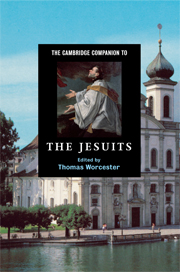Book contents
- Frontmatter
- Introduction
- Part I Ignatius of Loyola
- Part II European Foundations of the Jesuits
- Part III Geographic and Ethnic Frontiers
- Part IV Arts and Sciences
- Part V Jesuits in the Modern World
- 15 The Suppression and Restoration
- 16 Jesuit schools in the USA, 1814-c.1970
- 17 Jesuit theological discourse since Vatican II
- 18 Jesuits today
- Select bibliography
- Index
16 - Jesuit schools in the USA, 1814-c.1970
from Part V - Jesuits in the Modern World
Published online by Cambridge University Press: 28 September 2008
- Frontmatter
- Introduction
- Part I Ignatius of Loyola
- Part II European Foundations of the Jesuits
- Part III Geographic and Ethnic Frontiers
- Part IV Arts and Sciences
- Part V Jesuits in the Modern World
- 15 The Suppression and Restoration
- 16 Jesuit schools in the USA, 1814-c.1970
- 17 Jesuit theological discourse since Vatican II
- 18 Jesuits today
- Select bibliography
- Index
Summary
In 1855, James Oliver Van de Velde, Jesuit bishop of Natchez, Mississippi, described the educational ministry of the restored Society in America. “Wherever our Fathers have commenced colleges,” he told an English friend, “they have succeeded beyond their expectations.” They thrived even though “in most cases they were foreigners, Belgians and French, scarcely acquainted with the language of the country.” The bishop's boast underscored a defining feature of early Jesuit schooling: its domination by Europeans. Although American- and English-born Jesuits directed Georgetown College (founded 1789) following the Society's reconstitution in 1814, succeeding institutions were forged by émigré clerics. St. Louis University was run by Belgians; French expatriates launched institutions in Alabama, Kentucky, and New York; and Woodstock College, the Order's national seminary in Maryland, was the creation of exiled Neapolitans. German Jesuits, deported by Bismarck's Kulturkampf, founded five schools across the northeast from New York to the Mississippi River. In the Far West, Italians and other immigrant priests operated colleges in Santa Clara, San Francisco, Denver, Spokane, and Seattle. The schools' foreign provenance had far-reaching implications. As the historian Philip Gleason has observed, Catholic institutions, including those run by Jesuits, stood apart socially, organizationally, and ideologically from native academies. They were socially distinct because the majority of teachers and students were newcomers. Organized along European lines by refugee clerics subject to European oversight, they were also administered differently than mainstream colleges.
- Type
- Chapter
- Information
- The Cambridge Companion to the Jesuits , pp. 278 - 297Publisher: Cambridge University PressPrint publication year: 2008
- 3
- Cited by



